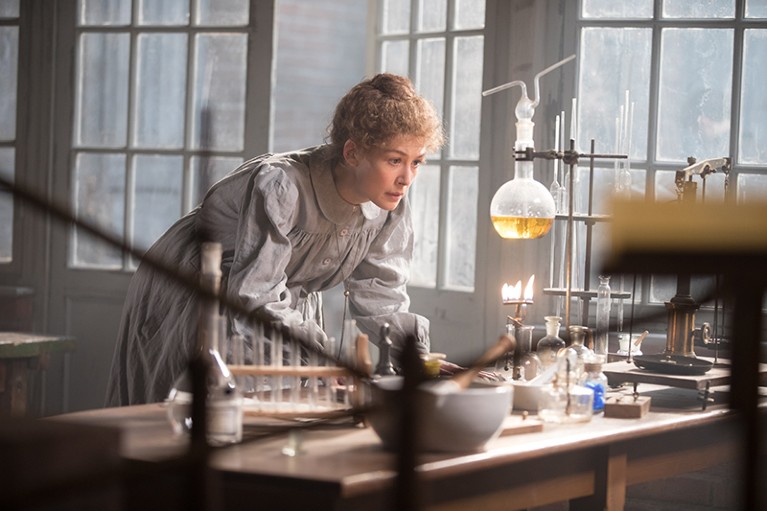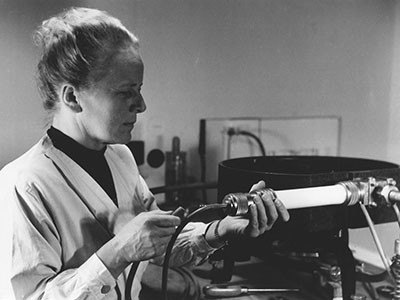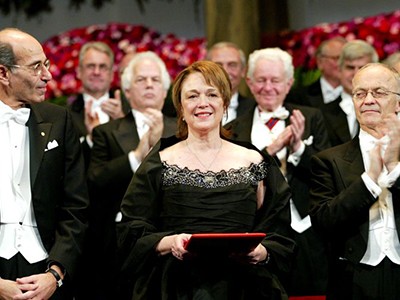
Rosamund Pike plays Marie Curie in Radioactive.Credit: StudioCanal and Amazon Content Services
Radioactive Director: Marjane Satrapi Shoebox/Working Title/StudioCanal (2019)
Surfaces in Radioactive catch the eye. Rainwashed Parisian cobbles, blackboards, laboratory glassware, the textures of linen and woollen clothing, even — startlingly — naked skin; all are carefully framed and lovingly lit. But this is a film that should be about inner workings: of the atom, certainly, and of the mind and emotions of an extraordinary woman. Who was Marie Curie, and how did she become the only person ever to win Nobel prizes in two scientific disciplines? Radioactive gives only a partial answer.
The action begins in the 1890s, with the young Polish physicist Marie Skłodowska, played by Rosamund Pike (who sought scientific advice on the role from senior Nature correspondent Elizabeth Gibney). Established in Paris as an independent researcher, she is unsuccessfully fighting dour professor Gabriel Lippmann (an undemanding role for a bewhiskered Simon Russell Beale) for resources to continue her work on the properties of steel. How she came to leave Warsaw for Paris, and what inspired her passion for science, are left to the imagination.
Celebrate the women behind the periodic table
Thereafter, the film unfurls as a sequence of big moments in Curie’s career. Marie literally bumps into Pierre Curie (Sam Riley) in the street! Marie rejects, and then accepts, Pierre’s offer of lab space! Pierre gives Marie an electro-meter and she agrees to collaborate on investigating the properties of uranium! They fall in love and go skinny dipping! It felt like a graphic novel, and only later did I remember that French Iranian director Marjane Satrapi first found fame for her graphic-novel series Persepolis, published between 2000 and 2003.
Free with the facts
The historical accuracy of these graphic frames is variable, and although dramatic licence is legitimate, there are limits. One particularly egregious example is a scene in which Pierre returns from Stockholm after giving his Nobel lecture, to find a furious Marie picking up children’s toys and berating him for treating her as “just a wife”. In fact, he refused to accept the 1903 prize for physics unless she was included as an equal partner. Neither of them attended the ceremony that year, and both went to Stockholm two years later, when Pierre actually delivered the lecture.
The recreation of the period setting is more successful. The bare shed that the Curies convert into a lab to conduct most of their important experiments is well realized, as are the severe black and navy outfits that Marie Curie favoured because they would not reveal her extremely dirty working conditions, pounding tonnes of pitchblende in a bathtub to extract radioactive materials for analysis.
Women who win prizes get less money and prestige
Pike does her best to inject psychological nuance into a script that is heavy on exposition. For instance, a conveniently ignorant guest provides an opportunity to deliver introductory atomic physics across the dinner table (a graphic animation is provided for the viewer’s benefit). And Pike is given few opportunities to deviate from an emotional register tuned to ‘angry and frustrated’. The moment when, alone, Marie gives way to grief at Pierre’s shocking death in a 1906 traffic accident is genuinely moving.
Yet the most rewarding pairing in the film is between Marie and her 17-year-old daughter Irène (Anya Taylor-Joy) as they establish mobile radiography units during the First World War and drive them into the battlefield to X-ray wounded soldiers and prevent unnecessary amputations by gung-ho military surgeons. We also see Marie’s pride in Irène’s own research on artificial radioactivity, which would win her and her husband Fréderic Joliot their own Nobel prize just a year after Marie’s death.
How convincing is this portrayal of the life scientific? Satrapi’s film falls straight into the ‘lone heroes’ trap, presenting Marie as a solitary battler with only her faithful husband and daughters (plus a few students) on her side. Before the closing credits, a genuine historical photo flashes up, of Marie Curie at the 1927 Solvay Conference in Brussels with Albert Einstein, Niels Bohr, Erwin Schrödinger and all the other luminaries of early-twentieth-century physics. Apart from this one image, the film gives no sense that she was a respected equal member of this international community, and so distorts both her position as a female scientist and the reality of how science advances.
Satrapi could have allowed the story to evolve at a more leisurely pace had she spent less time hammering home the legacy of the Curies’ work on radioactive elements. As the conversation between the pair turns towards possible therapeutic uses, we are transported to a mid-twentieth-century cancer clinic in the United States, where a wide-eyed little boy is to receive radiotherapy for a tumour. Similar flashes forward take in the nuclear attack in Hiroshima in 1945; bomb tests in the Nevada Desert in the 1960s; and the reactor meltdown at Chernobyl in 1986. Radioactive is based on the beautifully illustrated and scrupulously referenced 2010 Curie biography of the same name by author and artist Lauren Redniss — adapted by screenwriter Jack Thorne — which made similar allusions, but for me these scenes simply don’t work in the context of the film.
In his Nobel lecture (as accurately enacted in Radioactive), Pierre Curie asked “whether mankind benefits from knowing the secrets of Nature, whether it is ready to profit from it or whether this knowledge will not be harmful for it”. Neither he nor Marie foresaw just how harmful radioactivity could be — nor how beneficial. Cinemagoers of 2020 know only too well, yet the director has not trusted her audience to make the links between what scientists discover, and the use society makes of those discoveries.
To too many, Marie Curie is little more than the name of a pioneering female scientist, associated in some way with radioactivity (a term she coined). Radioactive fills in much of the detail of her scientific and personal life, and is worth watching if you don’t already know the story. Ultimately, I wished that the filmmakers had trusted viewers to find interest in the complex, driven, passionate woman at the heart of this story because of her intense desire to solve nature’s secrets, not in spite of it.


 Celebrate the women behind the periodic table
Celebrate the women behind the periodic table
 Women who win prizes get less money and prestige
Women who win prizes get less money and prestige
 In pursuit of female chemists
In pursuit of female chemists








